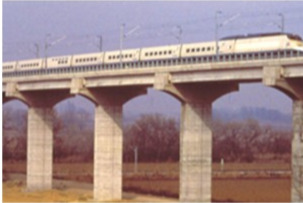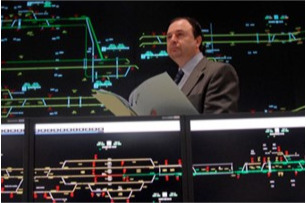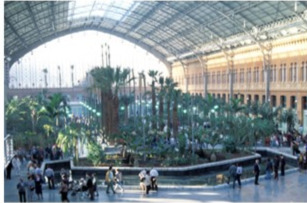Madrid - Seville Line
Main axis of central and southern mainland Spain
Main axis of central and southern mainland Spain
The Madrid-Seville High-Speed Line is an important communication axis across the regions (Madrid, Castile-La Mancha and Andalusia),
In addition to the cities on the line (Madrid, Ciudad Real, Puertollano, Cordoba and Seville), the Toledo and Malaga high-speed lines also branch from it. Moreover, thanks to gauge changers, railway traffic from Cadiz, Huelva, Malaga, Granada and Algeciras can also enjoy the benefits of this line, including improved travel times and better service.
From 1992 to 2011, 56 million people have travelled on the AVE, between Seville and Madrid, and more than double, 118 million, on different trains running on this first high-speed line in Spain
European Funding
Information on the aids and financing received by Adif from the different European Union (EU) funds and programmes:
" A way to make Europe”
Current situation
Current situation
Quality service
The main challenge for this first Spanish high-speed line was its construction, but equally important was the challenge of maintaining and improving the infrastructure and the rail services, applying high quality standards.
In this regard, the history of this line is marked by awards and prizes received for the service that has achieved the status of excellence according to the existing quality yardsticks. Examples are the European Quality Award, the highest award related to quality management and business excellence in Europe, obtained for service in 1998, and the European Seal of Excellence, certifying an evolution of continuous improvement in management, awarded by the Quality Management Club to the AVE in 2000.
Another significant example is that, 15 years after opening, as a result of learning, experience and improved management, the cost of maintenance per kilometre of track of the High-Speed Network had been reduced by around 50 percent, despite an increase in traffic of some 300 percent.
Evolution
The Madrid-Seville high-speed line, designed to allow speeds of up to 300 km/h, is currently operating at its highest performance levels. Since its commissioning, several improvement projects have been carried out on the line, which have enabled quality levels to be raised.
Pioneering technologies were installed on this line at the time, such as the LZB, which continuously monitors speed with bidirectional data transmission between track and train and enables automatic train driving. There are plans for future implementation of the European Railway Traffic Management System (ERTMS), which will allow improved security features and increased speed.
On 23 April 1993, an Ave Series 100 (100-015) train set an historic Spanish railways speed record, reaching 356.8 km/h, with no modifications to the vehicle.The tests allowed commercial operation at 300 km/h in 1994, reducing the previous journey time between Madrid and Seville by 40 minutes. This record was surpassed 13 years later on the Madrid-Barcelona line.On the night of 15-16 July 2006, a Series 103 (103-002) train set the current Spanish speed record of 404 km/h, also with an unmodified train.
In terms of the track, important work has been carried out to improve the cant on different sections, which has allowed an increase in speed from 250 to 300 km/h without affecting comfort levels or increasing track stress.
Among the improvements to adapt to new high-speed standards, work has been carried out, including changing the electrification system 25 Kv. c/a, 50 Hz, as well as the installation of telecommunications via GSM-R23.
Finally, it is worth highlighting the railway traffic control modernisation, thanks to the DaVinci System, one of the most advanced traffic systems in the world, which integrates all the systems that make up the elements of a Regulation and Control Centre into a single application.
The longest is 2,540 metres





